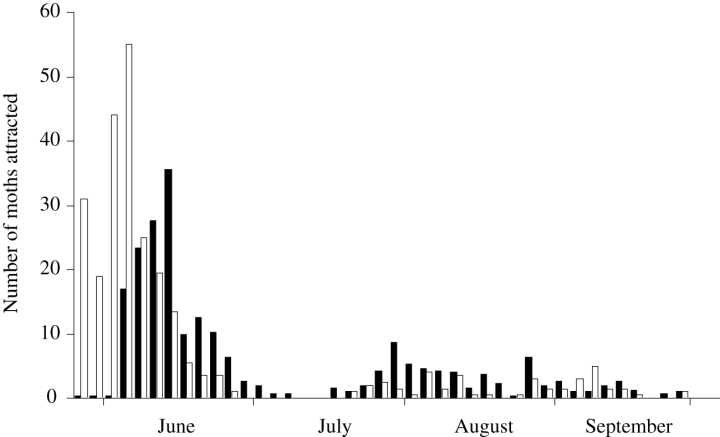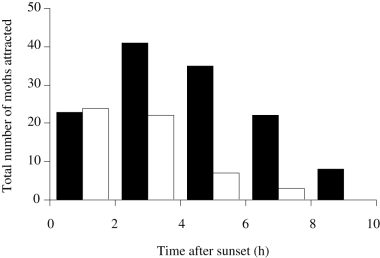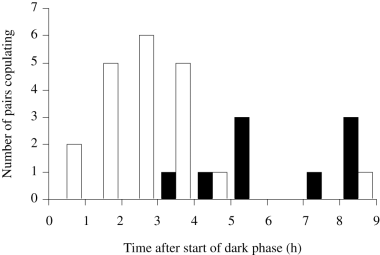Difference in the time of mating activity between host-associated populations of the rice stem borer, Chilo suppressalis (Walker)
Abstract
Mating activities of the rice stem borer, Chilo suppressalis, were compared between rice- and wateroat-feeding populations, and two potential temporal factors that may act as reproductive barriers were examined. Seasonal data of the number of moths attracted to pheromone traps showed that the peak of emergence at the rice field was approximately 10 days earlier than that at the wateroat vegetation in the first flight season, although there was a broad overlap of emergence at the two locations. Both field observations and a laboratory experiment showed that moths from the rice field started mating earlier than those from the wateroat vegetation. However, whereas the difference was distinctive in the laboratory experiment, mating activity at the wateroat vegetation shifted significantly to an earlier time phase than that observed in the laboratory. Body size data showed that the male moths attracted to the pheromone traps at the wateroat vegetation were significantly larger than those at the rice field, suggesting that the traps at the two locations mainly attracted moths originating from different host plants. However, pheromone-trapped males at the rice field were significantly larger than those reared from overwintering samples. These results support the idea that males from the wateroat vegetation migrate to the rice field. The differences in seasonal and temporal mating activity and their effects on development of reproductive isolation between host-associated populations are discussed.
INTRODUCTION
Evolution of reproductive isolation is a critical process in speciation, and has been a central focus in evolutionary biology (Mayr 1970). Recent studies on herbivorous insects indicate that adaptation to a different host plant phenology can lead to a shift in insect emergence time, and isolation by seasonal allochrony may result in reproductive isolation between host-associated populations in sympatric conditions (Wood & Keese 1990; Craig et al. 1993; Feder et al. 1998). Reproductive isolation can also be caused by allochronic isolation on a finer scale, that is, a temporal shift in circadian activity patterns. Different mating times among host-associated populations have been reported for eight species of Yponomeuta (Hendrikse 1979), fruit- and Pinaceae-feeding types of Dichocrocis punctiferalis (Konno et al. 1981), and rice and corn strains of the fall armyworm (Pashley et al. 1992). Genetic differentiation among host-associated populations of Yponomeuta (Menken 1981) and the fall armyworm (Pashley 1986) suggests that these species are representatives of an incipient stage of speciation and support the idea that temporal allochrony serves as a mechanism of reproductive isolation.
The rice stem borer, Chilo suppressalis (Walker), is an important pest of rice plants (Oryza sativa), and is also known to use wateroat (Zizania latifolia Turcz.). Wateroat-feeding individuals are known to reach larger body sizes than rice feeding ones (Tsuchida & Ichihashi 1995). Given the agricultural importance of this species, field studies involving population monitoring at rice fields have been conducted (Kondo & Tanaka 1991; Kondo et al. 1993), but the general life history traits of rice stem borers when feeding on wateroat are not well understood. The results of previous studies have indicated that the peak mating time of rice-feeding strains is significantly earlier than that of wateroat-feeding strains under experimental conditions: rice-feeding and wateroat-feeding strains had mating peaks at 2–4 h and 7–9 h after the start of the dark phase, respectively (Konno & Tanaka 1996b; Samudra et al. 2002). Although the peak mating time of rice-feeding populations under field conditions was consistent with that observed in laboratory conditions (Tatsuki et al. 1975; Kanno 1984), until now, there has been no corresponding information for wateroat-feeding populations. In the present paper, we report the mating activity of a wateroat-feeding population in nature, and examine two potential temporal factors that may act as a reproductive barrier between rice-feeding and wateroat-feeding populations: (i) allochronic isolation through a seasonal difference in adult emergence; and (ii) temporal isolation through different mating activities.
MATERIALS AND METHODS
Mating activity of adult male C. suppressalis moths was monitored using sticky traps baited with synthetic pheromone lures (SE trap; Sankei-Chemicals, Kagoshima, Japan). Traps were placed in a rice field and in a patch of wateroat vegetation, which were approximately 7 km apart. The wateroat vegetation was at the shore of Sagata Lake, a shallow sand lake in the outskirts of the city of Niigata in north-western Japan, which is closely surrounded by rice fields, and was the closest population of wateroat vegetation to the rice field. Trapped moths were collected every 3 days from 26 May to 2 October 1997. At the wateroat vegetation, traps were replaced after three collection trials, as few moths were attracted. Temporal mating activity at the two locations was assessed by collecting the traps every 2 h after sunset. This collection was carried out on 5, 7, 8, 10 and 12 June, when the adults were most abundant.
Overwintering larvae and pupae were also collected from the two locations. They were kept in the laboratory at 25°C and with a photoperiod of 15 h light : 9 h dark (LD 15:9). After males and females emerged from overwintering, mating activity was examined under experimental conditions. Five virgin males and five virgin females from the same location were placed in a cage (300 mm × 300 mm × 300 mm), and mating behavior was observed every 10 min during the 9-h dark phase, by using darkroom lighting. Adults of 1–3 days old were used.
The head width of all moths was measured with digital calipers to the nearest 0.01 mm. The head widths of the moths from the rice field and wateroat vegetation were compared to determine any host-associated differences in the two populations. Also, the pheromone-trapped males from each location were compared with the overwintering samples to examine whether and how host-associated body size differences were realized in the pheromone-trapped moths.
RESULTS
Seasonal data based on the number of moths attracted to the pheromone traps showed that the peak of emergence occurred in June (Fig. 1). There was an interruption in emergence at the beginning of July, and then a second period of emergence, which was less distinct and on a smaller scale, followed from late July to the end of September. The peak of emergence at the rice field was approximately 10 days earlier than that at the wateroat vegetation during the first flight season, although there was a broad overlap in emergence at the two locations.

Number of male moths attracted to the pheromone traps. (□), Collected at the rice field; (▪), collected at the wateroat vegetation.
The temporal mating activities of moths from the rice field and the wateroat vegetation were significantly different (χ21 = 21.0, P < 0.001). At the rice field most adults were attracted within 4 h after sunset, and no individual was trapped after 8 h (Fig. 2). In contrast, individuals from the wateroat vegetation had a broader mating activity, with a peak at 2–6 h after sunset.

Nocturnal behavior of male moths. (□), Males collected at the rice field; (▪), males collected at the wateroat vegetation.
The difference in temporal mating activity was more distinct when moths obtained from the overwintering samples were examined under laboratory conditions (χ21 = 14.1, P < 0.001). Most moths originating from the rice field initiated mating within 4 h after the start of the dark phase, with a peak at about 2.5 h after the start of the dark phase (Fig. 3). Moths from the wateroat vegetation started mating at, on average, approximately 6.5 h after the start of the dark phase, and no mating was observed within the first 3 h of the dark phase.

Number of copulations observed in the laboratory. (□), Moths collected from the rice field; (▪), moths collected from the wateroat vegetation.
The temporal pattern of mating activity at the rice field was not significantly different from the time of copulation under laboratory conditions observed for the moths obtained from the overwintering samples (χ21 = 0.035, P = 0.853). However, mating activity at the wateroat vegetation occurred significantly earlier than that of the moths observed under laboratory conditions (χ21 = 5.94, P = 0.015).
Moths from the wateroat vegetation were significantly larger than those from the rice field (Table 1). Moths obtained from both overwintering samples and pheromone traps had a significant host-associated difference in head width. Moths from the pheromone traps at the rice field were significantly larger than those from the overwintering samples from the rice field (F1,236 = 23.134, P < 0.001), whereas no significant difference was detected for samples originating from the wateroat vegetation (F1,247 = 1.462, P = 0.228).
| Rice field | Wateroat vegetation | F | P | ||
|---|---|---|---|---|---|
| Overwintered sample | Male | 1.35 ± 0.01 (107) | 1.81 ± 0.02 (79) | 393.480 | <0.001 |
| Female | 1.44 ± 0.03 (68) | 1.83 ± 0.02 (53) | 48.884 | <0.001 | |
| Pheromone trap sample | Male | 1.57 ± 0.01 (170) | 1.79 ± 0.01 (196) | 157.653 | <0.001 |
- Values in parentheses are sample sizes. A statistical test to compare head width between the two locations was performed after data were log-transformed.
DISCUSSION
In the present study, field observations and a laboratory experiment showed that moths from the rice field started mating earlier than those from the wateroat vegetation, which is consistent with the results of previous studies (Tatsuki et al. 1975; Kanno 1984; Konno & Tanaka 1996b; Samudra et al. 2002). However, whereas the difference was distinctive in the laboratory experiment, mating activity at the wateroat vegetation shifted to a significantly earlier time than that observed in the laboratory. A possible explanation for the temporal difference in mating activity between field observations and the laboratory experiment is that the presence of sex pheromones from rice-feeding females in the field may cause earlier mating activity in males from the wateroat vegetation and promote recruitment of males to the rice field. Whether coexistence of sex pheromones from different host-associated populations affects temporal mating activity, especially that of the wateroat-feeding males, is crucially important in the development of reproductive isolation between the host-associated populations.
Body size data showed that the males attracted to the pheromone traps at the wateroat vegetation were significantly larger than those at the rice field, suggesting that the traps at the two locations mainly attracted moths originating from the respective different host plants. However, pheromone-trapped males at the rice field were significantly larger than those reared from the overwintering samples. These results are consistent with the possibility of migration of males from the wateroat vegetation to the rice field. Kondo and Tanaka (1994) reported that the mean flight distance of artificially marked male moths during one night was 112.0 m in the first flight season and 18.8 m in the second flight season. This suggests that the moths are able to migrate between the two host plants. However, at the wateroat vegetation, no significant difference was recognized between the pheromone-trapped males and the overwintering samples. Further studies are necessary to determine whether and how the body size patterns reflect asymmetrical migration and/or are dependent on factors such as the relative abundance of host-associated populations and effective distance of sex pheromone released from the populations.
A seasonal difference in emergence time was detected in the present study. However, the difference was not very large, and whether and to what degree the seasonal difference can act as a reproductive barrier is not clear. Because there is no evidence for any postmating reproductive isolation mechanism in this species (Koike et al. 1981), the substantial overlap evident in seasonal and temporal mating activity suggests that some gene flow between the host-associated populations is unavoidable. Tanaka et al. (1981, 1982, 1983) found a significant difference in insecticide susceptibility between host-associated populations in south-west Japan. Differences in aliesterase isozyme patterns suggest that the host-associated populations are reproductively isolated (Konno & Tanaka 1996a), but it is also possible that the difference in the aliesterase isozyme pattern reflects the effect of insecticide selection on the rice field population. Research on genetic differentiation between host-associated populations, using selectively neutral genetic markers, are of critical importance.
ACKNOWLEDGMENT
We would like to thank Peter de Jong for comments on and corrections to the manuscript.




